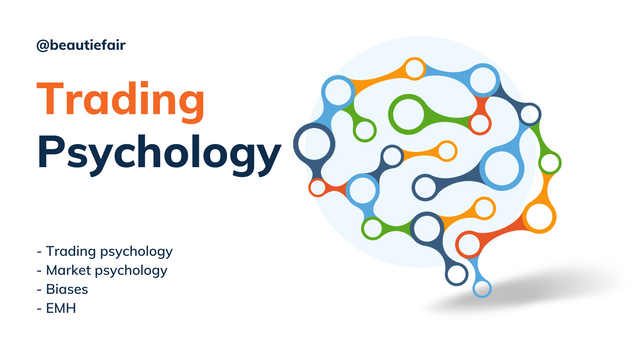
Part A (Case Study)
The case study given is an example of what type of psychology? Explain the reason for your answer.
Jane's case study is an illustration of trading psychology. Because trading psychology is solely concerned with an individual's state of mind while trading, all of her actions were based on personal feelings and judgment.
However, it is critical to recognize the role of market psychology in this scenario, as market psychology influenced Jane's psychological state and led her to make the trading decisions she did.
The key takeaway here is that, while Jane may be held liable for her actions as a result of her trading psychology at the time, there is a clear and strong link between market psychology and one's trading psychology.
Using the case study above, list and explain at least 5 biases that influenced Jane's trading behaviour with examples of how it affected her behaviour?
The following biases could have influenced our trading behaviour based on the case study of Jane's behaviour:
- Emotional bias
- Disposition bias
- Representative bias
- Anchoring bias
- Bounded rationality bias
Emotional bias: Jane's emotional bias was demonstrated when, in the hopes that the asset she held would correct immediately, she jumped into the market and purchased more cryptocurrencies, effectively averaging down her position. This action was also a representation of her greed. Jane's trading decisions and subsequent behaviour were largely influenced by her emotional state.
Disposition bias: Jane's averaging down action revealed and demonstrated her disposition/loss aversion bias. Jane was not quick to recognize and admit her poor trading decisions and actions; instead, she was focused on avoiding losses. This action is linked to her emotional bias, as she averaged down her position in the hope that the market correction would result in higher returns and profits.
Trend-chasing bias: Jane was more interested in the trend. Due to how frequently she has heard about this currency, she has most likely already decided in her heart that her investment will be a good one, and that she will only see price increases over time. Jane might have been interested in other penny currencies if she hadn't been "trend-chasing biased," or she might have done a thorough analysis before investing if she hadn't been "trend-chasing biased."
Anchoring bias: Jane suffered from anchoring bias because she relied solely on one source of information, the telegram group. This was our first and last source of trading data, which resulted in poor trading results.
Bounded-rationality bias: Jane was influenced by this bias because she failed to consider the entire picture. She never properly weighed the pros and cons of trading and was only concerned with profits rather than losses. It's no surprise she became upset when things didn't go as planned.
List and explain how each bias you have mentioned can be avoided?
Jane could have avoided her bias by doing the following:
For emotional bias: Learning more about the market.
For disposition bias: Creating a trading plan and sticking to it.
For trend-chasing bias: Performing a fundamental analysis.
For anchoring bias: Expanding her information source.
For bounded rationality bias: Being realistic about trading.
Overcoming emotional bias by learning more about the market: When knowledge is lacking, a person is left to rely solely on their emotions, as Jane was. Jane could make better decisions by tapping into her knowledge store rather than her emotions if she learned more about cryptocurrencies and trading.
Overcoming disposition bias by creating a trading plan: Jane could have been in a better position with fewer regrets if she had created a realistic trading plan that included all of her trading actions and strategies, such as how much risk to absorb, trading length, and investment amount.
Overcoming representative bias by performing fundamental analysis: Jane was setting herself up for disaster by omitting fundamental analysis (seeking information about an asset), as she failed to thoroughly investigate and comprehend factors that could influence the asset's value, knowledge of which would have aided her decision-making process and trading behaviour.
Overcoming anchoring bias by expanding information sources: Over-reliance on a single source of information can be deceptive and potentially disastrous, as Jane's case demonstrated. Her excessive reliance on her telegram group only allowed her to obtain information based on the group's singular point of view. Jane could have gained a better understanding of the market situation by expanding her information sources, which could have had a significant impact on trading psychology and behaviour.
Overcoming bounded rationality bias by being realistic about trading: While trading is all about making money, a realistic trader must recognize that there are times when losses are inevitable. Jane was blind to this fact and was only concerned with making a profit. These facts will help traders like Jane stay sane and make contingency plans at all times.
Part B (Research & Analysis)
What type of analysis can be used to monitor market psychology and trading psychology, and why? Identify the differences between trading psychology and market psychology.
"Technical analysis" is the most common method of monitoring market psychology. Technical analysis is the process of examining market price and volume trends in order to assist a trader in identifying trading opportunities. Technical analysis and accompanying technical indicators can be used to look at past trends and make predictions about future trends.
Technical analysis is an important tool for traders because it allows them to see what the collective community of traders is thinking. Using technical indicators, a trader can see which assets are popular and most favoured and which ones aren't.
A trader can obtain a snapshot of trends in relation to a specific asset, particularly price movements and volumes, by performing technical analysis. These data are crucial to a trader's success because they can assist them in making good trading decisions and exhibiting positive trading behaviours.
Differences between Trading Psychology and Market Psychology
| Differentiating factor | Trading psychology | Market psychology |
|---|---|---|
| Number of persons | Trading psychology involves just an individual’s psychological disposition at each point in time. | Market psychology is a collection/sum of the psychological state of all traders at each point in time. |
| Trend setting | A person’s trading psychology as an individual do not always have significant impact on the market (in exception of whales) | Trading psychology of several individuals are known to set market trends and movements in the value of different securities |
| Influence | An individual’s trading psychology is a reflection of his experience, knowledge, trading skills and ability to master their emotions. | Market psychology is influenced by group factor as it is a consequence of the trading psychology of all investors/traders at a point in time |
| Psychological biases | The presence of psychological biases could be applied more to trading psychology as this involves a single individual whose biases could lead to different trading behaviours | While collective psychological biases of traders could affect market trends, the market is a collection of individuals; thus, psychological biases cannot be applied to it as the market do not have a mind of its own. |
How can you measure market psychology using a crypto chart? Select 5 trading biases and explain with screenshots of any cryptocurrency chart how the biases can cause a coin to be oversold and overbought. (Add watermark of your username)
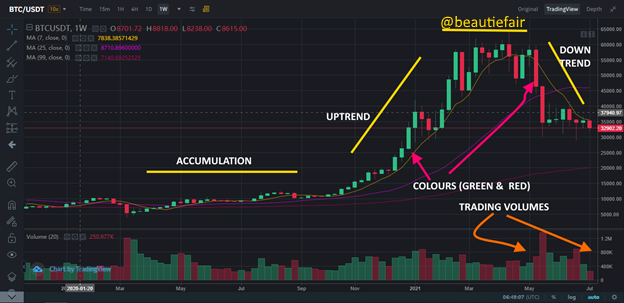
Using the chart above (a one-week BTC/USDT chart), we can measure market psychology, in three ways, starting from the simplest to the moderately complex method:
- Using candlestick colours
- Using trading volumes
- Using market stages
Candlestick Colours: This is a very basic level of analyzing market psychology, and provides at a glance/quick overview of the market psychology. If a trader sights a trading chart and could only find green candle sticks all over, it is a good sign that there is a positive market psychology as investors seems optimistic; in another situation where the reds are prominent, it is a quick negative depiction of the market psychology.
Trading volumes: Trading volumes shows how much of an asset is being traded at a particular point in time with reference to such assets all-time highs and lows. The higher the trading depicts positive market psychology as traders are buying more of the said asset as they consider it a good investment; while when the asset volume is low, market psychology is low as traders are trading off their positions.
Market stages: The market goes through various stages as depicted in the chart above. Each stage may reflect the overall sentiment of the traders in general:
Accumulation stage: At this point, crypto assets are priced low and market movement is stable (buys equals sells) as market psychology is low. However, individuals may accumulate assets gradually as they felt positive about the asset in question as there are no much drifting in asset’s value.
Uptrend (bullish): A positive psychology exhibited by traders will lead to more purchase of BTC/USDT as shown above driving the price upwards. This is also a depiction of excitement and hope in traders, and traders will likely want to take positions at this stage.
Downtrend (bearish): The apprehensiveness and fear by the market players will cause a price drop. At this point, there is a negative psychology surrounding this asset.
Select 5 trading biases and explain with screenshots of any cryptocurrency chart how the biases can cause a coin to be oversold and overbought. (Add watermark of your username)
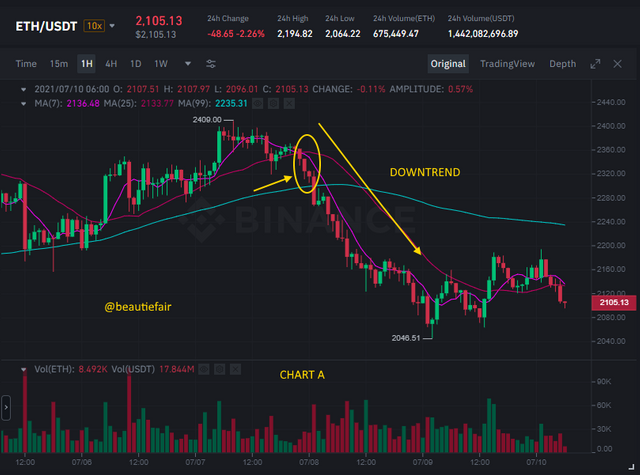
Emotional bias: The chart A above could be used to illustrate the point at which an emotional bias kicks in. At the point of bearish movement someone can out of fear sell off their assets to avoid huge losses. This could lead to an over sale of asset.
Herd mentality bias: A trader that may examine the chart A above, and conclude, “everyone is selling their position, I must do likewise”, in this instance this could lead to over sale of the cryptocurrency.
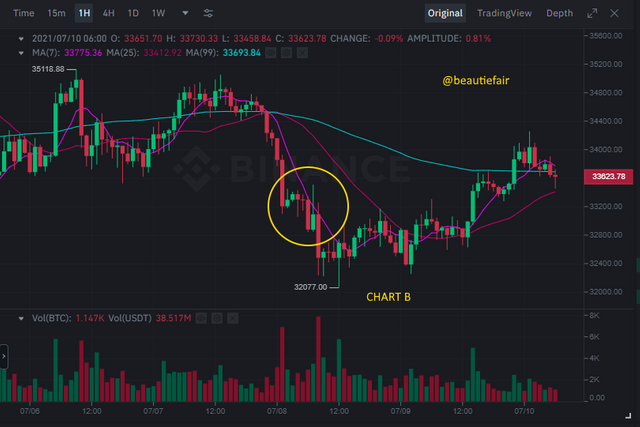
Trend-chasing bias: The BTC/USDT chart above show trend chasing as individuals are usually willing to invest and reinvest in Bitcoin as it has a long track record of success. New/novice investors are more likely to fall into this trap, and this leads to the coin being overbought.
Loss aversion bias: The circled area in chat be shows the loss aversion attitude of traders. Irrespective of the downtrend movements, traders may out of the need to avoid losses invest more to cover for their already incurred losses as shown above.
Or This
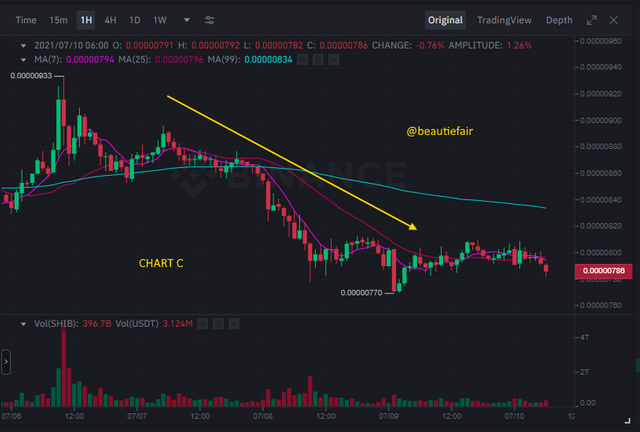
Confirmation bias: If a trader may have been apprehensive about investing in the crypto asset (SHIB/USDT) shown in chart above, on looking at this chart, he can confirm his reasons to desist from this currency and even sell of his position if he had invested already as the downtrend movement could help confirm his initial apprehensions.
In your own words, define the term Efficient Market Hypothesis (EMH). List and explain the advantages and disadvantages of Efficient Market Hypothesis (EMH).
The Efficient Market Hypothesis (EMH) states that the price of a security at any given point in time in the market is a reflection of all available information about that security at that time. As a result, no type of analysis, whether technical or fundamental, could help a trader beat the market.
The Efficient Market Hypothesis (EMH) is of the following ideas:
- financial market is difficult or impossible to predict
- Financial market is instantaneous and it’s not influenced by past trends or events
- Financial market is perfect and always trade its assets for a fair value
- Investors are only left with the choice of speculative and often high risk investments
There are three (3) forms of Efficient Market Hypothesis (EMH), namely:
- Weak Efficient Market Hypothesis (EMH)
- Semi-strong Efficient Market Hypothesis (EMH)
- Strong Efficient Market Hypothesis (EMH)
Weak Efficient Market Hypothesis (EMH): This kind of Efficient Market Hypothesis (EMH) suggests that current market prices is an influence/consequence of all past prices but does not predict future price. For this reason, a technical analysis will be useless; however, a fundamental analysis could provide some trading advantage.
Semi-strong Efficient Market Hypothesis (EMH): This Efficient Market Hypothesis (EMH) holds that the market price is a reflection of all publicly available information at any instance; for this reason, only individuals with privately held information could gain a market advantage. In this case a fundamental or technical analysis will not be useful.
Strong Efficient Market Hypothesis (EMH): This Efficient Market Hypothesis (EMH) states that all currently available information both private and public influence the market at all point in time for this reason irrespective of the type of information at one’s disposal they cannot take advantage of the markets. Thus, the market is instantaneous, and there is no room for technical or fundamental analyses.
Advantages of the Efficient Market Hypothesis (EMH)
- It is time saving
- Its advocates passive investment
- It frees investors of too much trading ideologies
Disadvantages of the efficient market hypothesis
- It considers trading as gambling/ game of luck or speculation
- It fails to explain irregularities in the market
- It discourages technical and fundamental analysis
Advantages of the Efficient Market Hypothesis (EMH) - Explained
Timesaving: By leaving out or eliminating the need for technical and fundamental analysis traders can save time by adopting the Efficient Market Hypothesis (EMH).
Passive investment: According to the Efficient Market Hypothesis (EMH) traders are left with no option than taking on high risk investments so as to protect their capital. They are thereby left with no option than to invest what they are able to lose and do not have to invest too much time into the process. There is no need and no room for analytical risk taking.
Freedom from trading ideologies: By adopting the Efficient Market Hypothesis (EMH) traders may not need a wealth of experience or financial consultation to enter the financial markets. They are can just enter the market without being burdened by the numerous advice of acclaimed experts in technical and fundamental analysis as well as numerous recommendations on what assets should and not be bought. Thus, anyone, and everyone can be a trader.
Disadvantages of the Efficient Market Hypothesis (EMH) - Explained
Trading is gambling, a game of luck or is speculative game: According to the inherent idea of the Efficient Market Hypothesis (EMH) trading could be considered gambling as traders may not need to be analytical about the process. They can just dive into the market and accept whatever comes to them.
Efficient Market Hypothesis (EMH) do not explain market irregularities: Changes in the market and volatilities are not explained by the efficient market hypothesis. This hypothesis holds that the market is perfect.
Discourages fundamental and technical analysis: Several tools have been provided by market experts for fundamental and technical analysis and these tools have a long track record of successes among traders who use them. However, the Efficient Market Hypothesis (EMH) is of the idea that these tools are almost useless as the market is considered a perfect/efficient one.
Conclusion
Human psychology plays an important role in financial trading. One’s state of mind can either make or break a trade; thus, as one trains his/herself in being skilful with the use of trading tools, one must invest time in becoming a master of their mind.
Thanks once more to @asaj for this experience.
Hi @beautiefair, thanks for performing the above task in the second week of Steemit Crypto Academy Season 3. The time and effort put into this work is appreciated. Hence, you have scored 6 out of 10. Here are the details:
Remarks:
Overall, this is a good work. That said, you did not provide new information to this course. Most of the points you stated have already been mentioned by other participants.
You have limited your answers to the bias mentioned in my homework post, however, there's recency bias, information bias, availability bias and lots more. Also, while answering Question 4 and 5 you could have mentioned greed and fear index as well as other technical indicators that can be used to measure market psychology.
Downvoting a post can decrease pending rewards and make it less visible. Common reasons:
Submit